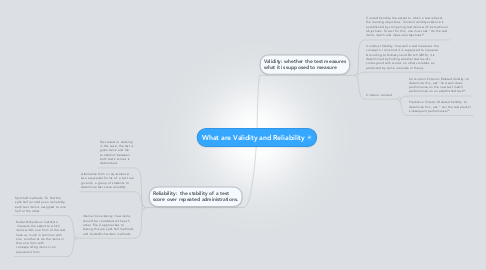What are Validity and Reliability
by Sandrine Amegnisse


1. Validity: whether the test measures what it is supposed to measure
1.1. Content Validity: the extent to which a test reflects the learning objectives. Content validity evidence is established by comparing test items with instructional objectives. To test for this, one must ask "do the test items match and measure objectives?"
1.2. Construct Validity: how well a test measures the concept or construct it is supposed to measure. According to Kubiszyn and Borich (2010), it is determined by finding whether test results correspond with scores on other variables as predicted by some rationale or theory.
1.3. Criterion- related
1.3.1. Concurrent Criterion Related Validity: to determine this, ask "how well does performance on the new test match performance on an established test?"
1.3.2. Predictive Criterion Related Validity: to determine this, ask " can the test predict subsequent performance?"
2. Reliability: the stability of a test score over repeated administrations.
2.1. Test-retest or stability: in this case, the test is given twice and the correlation between both tests' scores is determined.
2.2. Alternative form or equivalence: two equivalent forms of a test are given to a group of students to determine test score reliabilty
2.3. Internal Consistency: how items should be correlated with each other. The 2 approaches to testing this are split-half methods and Kuder-Richardson methods.
2.3.1. Split-half methods: To find the split-half (or odd even ) reliability, each test item is assigned to one half or the other.
2.3.2. Kuder-Richardson methods: measure the extent to which items within one form of the test have as much in common with one another as do the items in that one form with corresponding items in an equivalent form.
